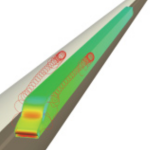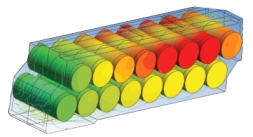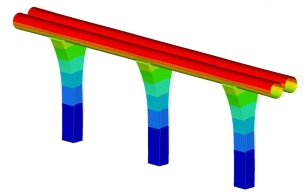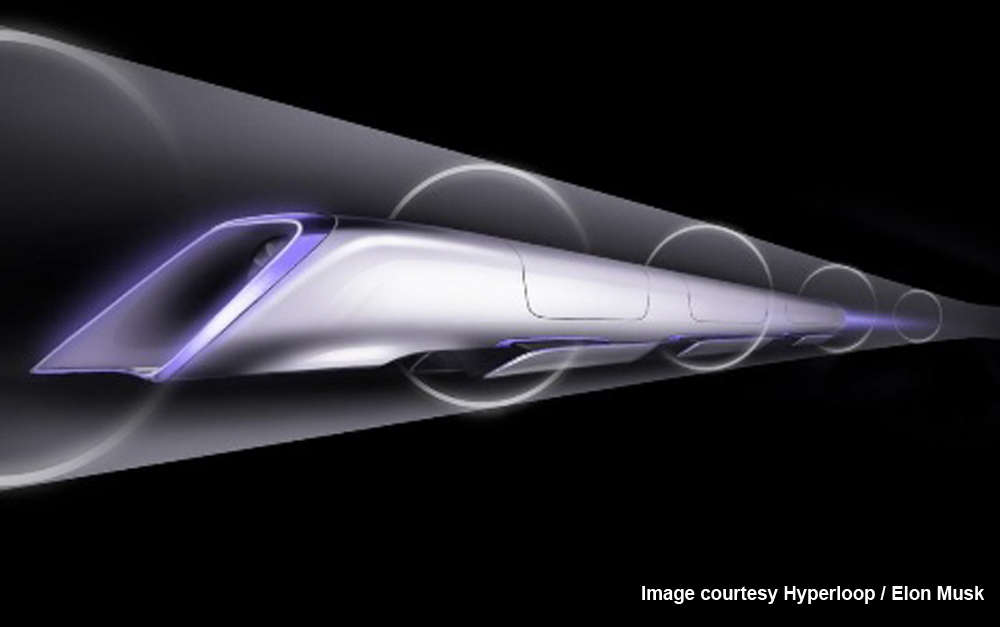This week marked the public release of Elon Musk's much anticipated proposal for a new mode of high-speed transport to be built between LA and San Francisco, dubbed the Hyperloop. The concept is equally compelling for other busy air routes of between 500-1000 km, such as Sydney to Melbourne (which is the 3rd busiest air route globally, according to Wikipedia). For engineers, the Hyperloop is an exciting concept which promises to provide an alternative to high-speed rail that is both faster, cheaper and more energy efficient, but the reality is that numerous engineering challenges need to be overcome to deliver this project on-time and on-budget with an acceptable level of safety (in one of the most seismically-active regions on earth!).
ANSYS Multiphysics software is uniquely placed to help the eventual collaboration partners make the Hyperloop a reality. Indeed, Elon Musk is no stranger to the ANSYS engineering community, with simulation technology already helping power two of his greatest achievements: SpaceX and Tesla Motors . Musk himself notes in his proposal the potential to use CFD and FEA engineering simulation tools to further reduce the cost of the Hyperloop, stating "additional technological developments and further optimisation could likely reduce this price" along with multiple references to the use of simulation technology (such as his comment that "aerodynamic drag will be improved and/or validated by computational methods").
Within the global ANSYS community, there are already individual examples of how ANSYS simulation technology is used to design, validate and optimise all of the individual components of the Hyperloop. For engineers here at LEAP Australia, the most intriguing part of the Hyperloop is that it is the perfect example of next-generation technological innovation that demonstrates the growing need for multidisciplinary engineering and predictive simulations combining multiple physics:
- fluid dynamics,
- electromagnetics and
- structural mechanics.
All of these physics have a unavoidable influence on the function, cost, efficiency and safety of all key aspects of the Hyperloop design.
As engineers, let's consider just some of the critical design components that will go into successfully delivering this innovative and (as yet) untested mode of transport, and how the use of CFD, FEA and Electromagnetics simulation tools will be used.
1. Capsule aerodynamics
 Streamlining of the capsule will reduce aerodynamic drag, as well as help identify the design and placement of the compressor used to ingest oncoming air and feed into systems for suspension and propulsion. Computational fluid dynamics simulations have already been used to demonstrate the validity of the Hyperloop's "compressor within a tube" concept.
Streamlining of the capsule will reduce aerodynamic drag, as well as help identify the design and placement of the compressor used to ingest oncoming air and feed into systems for suspension and propulsion. Computational fluid dynamics simulations have already been used to demonstrate the validity of the Hyperloop's "compressor within a tube" concept.
-
- vehicle external aerodynamics to minimise drag and maximise lift (to supplement air bearings), as well as avoid shock wave formation (relating to capsule/tube ratio)
- stability of air bearing suspension
2. Capsule onboard systems
The onboard compressor alleviates choked flow between the capsule and tube walls by bypassing air to the rear of the capsule, as well as supplying high-pressure air for the air suspension bearings that support the weight of the capsule.
-
- axial compressor
- composite pressure vessels
- intercooler
- electric motors
- onboard battery packs
- deployable wheels for low-speed motion, similar to aircraft landing gear

3. Tube design & construction
The partially evacuated cylindrical tube will need to be sized for optimal airflow around the capsule for optimum performance and energy efficiency. The tube itself will also incorporate linear motor stations (comprising the stator) which will locally accelerate (or deccelerate) the capsule. Likewise, the tube structure and elevated pylons will need to be designed for resistance to loads from extreme winds, earthquakes, possible terrorist threats as well as the normal weight and dynamics of capsule operation.
-
 earthquake/seismic studies
earthquake/seismic studies- industrial vaccuum pumps to maintain reduced tube pressure
- linear motor elements
- reinforced concrete pylons, which must be designed to allow longitudinal slip for thermal expansion, as well as dampened lateral slip to reduce risks due to earthquakes
4. Propulsion Systems
The propulsion system must rapidly accelerate the capsule to speeds between 480 & 1,220 km/hr and safely deccelerate the capsule at each end. The overall power requirements of the Hyperloop are influenced by propulsion motor efficiency, aerodynamic drag, battery charging requirements and vaccuum pump layout and power requirements.
-
- linear induction motor with optimised rotor (capsule) and stator (tube) designs
- inverters to accelerate outgoing capsules as well as recover energy from incoming capsules
- power electronics
5. Capsule Safety Design
-
- Crash worthiness of capsule and passenger seat constraints
And the list goes on! Whilst the engineering problems are numerous, the Hyperloop collaborators can take some confidence from noting that all of the individual components are already is use worldwide. For engineers however, it is the combination of these components (each with its own complex design challenges and coupled physics) that is the greatest challenge. I'm sure the teams at LEAP Australia and ANSYS Inc look forward to seeing the use of engineering simulation technology contribute to making Elon Musk's dream into a reality.
Images courtesy Hyperloop / Elon Musk, ANSYS Inc, INECO-TIFSA.






